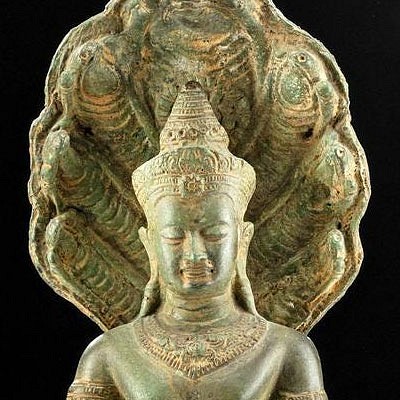Muisca Pottery Bullet Amphora w/ Negative Resist Motifs
Lot 101
About Seller
Artemis Fine Arts
686 S Taylor Ave, Ste 106
Louisville, CO 80027
United States
Selling antiquities, ancient and ethnographic art online since 1993, Artemis Gallery specializes in Classical Antiquities (Egyptian, Greek, Roman, Near Eastern), Asian, Pre-Columbian, African / Tribal / Oceanographic art. Our extensive inventory includes pottery, stone, metal, wood, glass and textil...Read more
Categories
Estimate:
$5,000 - $7,500
Absentee vs Live bid
Two ways to bid:
- Leave a max absentee bid and the platform will bid on your behalf up to your maximum bid during the live auction.
- Bid live during the auction and your bids will be submitted real-time to the auctioneer.
Bid Increments
| Price | Bid Increment |
|---|---|
| $0 | $25 |
| $300 | $50 |
| $1,000 | $100 |
| $2,000 | $250 |
| $5,000 | $500 |
| $10,000 | $1,000 |
| $20,000 | $2,500 |
| $50,000 | $5,000 |
| $100,000 | $10,000 |
| $200,000 | $20,000 |
About Auction
By Artemis Fine Arts
Aug 10, 2021
Set Reminder
2021-08-10 12:00:00
2021-08-10 12:00:00
America/New_York
Bidsquare
Bidsquare : Museum-Deaccession | Asian & Pre-Columbian
https://www.bidsquare.com/auctions/artemis-gallery/museum-deaccession-asian-pre-columbian-7316
An interesting mix of de-accessioned Asian and Pre-Columbian Art from The Ashland University Museum in Ashland, OH, originally donated between 1994 to 1998. All lots from the Museum have been noted, as such. Artemis Fine Arts info@artemisgallery.com
An interesting mix of de-accessioned Asian and Pre-Columbian Art from The Ashland University Museum in Ashland, OH, originally donated between 1994 to 1998. All lots from the Museum have been noted, as such. Artemis Fine Arts info@artemisgallery.com
- Lot Description
Pre-Columbian, Colombia, Piartal Cultural Complex, Highland Narino region, Muisca culture, ca. 750 to 1250 CE. A hand-built pottery vessel of a sizable form known as a bullet amphora, so called due to its projectile-shaped profile. The highly burnished vessel presents with an inverted piriform body and a low, conical base, a gently sloped shoulder that tapers to form the cylindrical neck, and a dramatically flared rim. The cream-hued exterior surfaces are graced with dense linear, curvilinear, zigzagging, and chevron motifs brought forth via the negative resist technique in earthen tones of black and red. The negative resist motifs extend across the body, up the neck, and even partially onto the rim and make this a truly attractive piece that will complement any discerning collection! Size: 9.2" W x 22.375" H (23.4 cm x 56.8 cm); 26.3" H (66.8 cm) on included custom stand.
Cf. Labbe, Armand J. "Colombia Before Columbus: The People, Culture, and Ceramic Art of Prehispanic Colombia." Rizzoli International Publications, New York, 1986, p. 164, plates XXXIX and XL
Provenance: private New York, USA collection; ex-Arte Primitivo auction, New York, New York, USA
All items legal to buy/sell under U.S. Statute covering cultural patrimony Code 2600, CHAPTER 14, and are guaranteed to be as described or your money back.
A Certificate of Authenticity will accompany all winning bids.
PLEASE NOTE: Due to recent increases of shipments being seized by Australian & German customs (even for items with pre-UNESCO provenance), we will no longer ship most antiquities and ancient Chinese art to Australia & Germany. For categories of items that are acceptable to ship to Australia or Germany, please contact us directly or work with your local customs brokerage firm.
Display stands not described as included/custom in the item description are for photography purposes only and will not be included with the item upon shipping.
#165535Repaired and restored from dozens of pieces, with restoration to large areas of neck, and resurfacing with overpainting along new material and break lines. Abrasions, nicks, and fading to original exterior pigmentation, with light encrustations within interior cavity, and a couple of stable hairline fissures. Nice preservation to original negative resist motifs on body and areas of neck.Condition
- Shipping Info
-
All shipping is handled in-house for your convenience. Your invoice from Artemis Gallery will include shipping calculation instructions. If in doubt, please inquire BEFORE bidding for estimated shipping costs for individual items.
-
- Buyer's Premium



 EUR
EUR CAD
CAD AUD
AUD GBP
GBP MXN
MXN HKD
HKD CNY
CNY MYR
MYR SEK
SEK SGD
SGD CHF
CHF THB
THB













